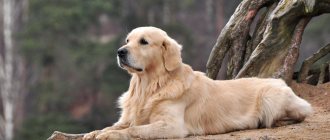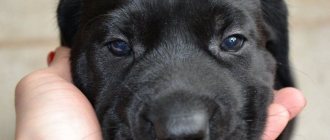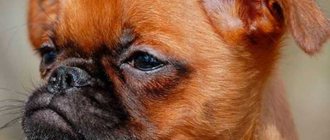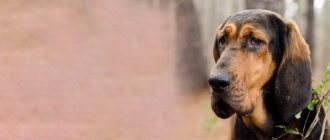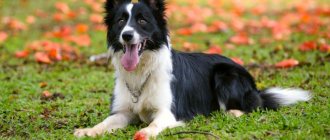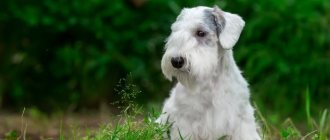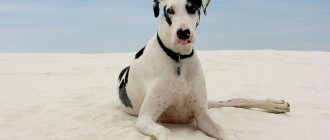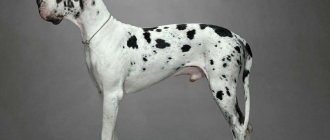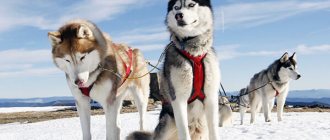Story
The German city of Rottweil is considered the birthplace of Rottweilers. In the Middle Ages, dogs were used to drive livestock and guard valuable property. The physical strength of Rottweilers has found application in the field of transporting goods and various goods. The advent of railway transport left the “four-legged drivers” without work. The number of Rottweilers and their popularity in Germany has declined sharply.
A general breed standard appeared only in 1901. In 1907, the first Rottweiler fan club was founded in Germany. The dogs were accepted into service with the German police. Dogs were brought to Russia in 1914.
History of the origin of the breed
To date, only very rare written data regarding the origin of the breed is known. This breed was first mentioned during the time of the legion of Claudius Augustus. These dogs, which were characterized as powerful, mastiff-like dogs, served in the army, accompanying them on long and grueling campaigns and guarding their property. After some time, the need for such guards disappeared, so the number of such dogs began to decline sharply and, at a certain period of time, the breed was on the verge of extinction. When one of the Rottweiler representatives appeared at the exhibition in Heilbron, he was not in the best shape.
As a result, German breeders decided to revive the breed. The result did not take long to wait and animals with excellent psychophysical characteristics were born. The police were the first to become interested and soon these dogs began to serve there, maintaining order. At the beginning of the 20th century, the United German Rottweiler Club was organized in Stuttgart. This made it possible to consolidate the breed standards of the animal. These standards are adjusted and supplemented from time to time.
Interesting to know! This breed first appeared in the vastness of our country more than a century ago. Due to the fact that Rottweilers have perfectly adapted to weather conditions, these dogs began to enjoy enormous popularity among various circles, including the military, as well as various security departments.
At the end of the 60s of the last century, individual specimens were imported from the GDR to our territory for breeding work. As a result of complex and painstaking work, it was possible to determine a number of breed defects that lead to disqualification. About 10 years later, individuals began to be imported from countries such as Denmark and Finland. Not so long ago, Rottweilers began to be in great demand in our country, as they are characterized by an attractive appearance, as well as an easy-going character.
ROTTWEILER. Pros and cons of the breed
Breed standard
- The Rottweiler is a large dog with a harmonious build.
- The head is massive, with a pronounced occipital protuberance and developed zygomatic arches.
- The eyes are oval, dark brown.
- The jaws are powerful, with a scissor bite.
- Lips are well pigmented.
- The ears are set wide apart and have a triangular shape.
- The neck is muscular, slightly arched at the top.
- The back is straight and strong.
- The chest is spacious and has considerable depth.
- The animal's front legs are set wide apart.
- The paws are round, with curved toes.
- The hind limbs are parallel and have developed muscles.
- The coat is relatively short and hard.
- There is a thick and dense undercoat.
- The color is black, with a dark brown tint.
- The height of an adult male can reach 58 cm.
- The weight of the animal is 45-50 kg.
Until 1998, the breed standard required docking of the animal's tail. Recent changes to FCI (Federation Cynologique Internationale) regulations specifically prohibit docking a Rottweiler's tail. A dog without a tail will not be allowed into exhibitions and competitions.
Possible deviations from the breed standard :
- Heterochromia (different eye colors).
- Missing several teeth.
- Light wool.
- Monorchism.
Rottweiler: description
This breed has excellent endurance and performance characteristics. The dogs are quite energetic and loyal, capable of protecting both the owner and his family members. Rottweilers are strong and powerful, while their body is proportional and compact.
Breed standards
The standards of this powerful, yet not heavy breed include the following characteristics:
- The head of Rottweilers is medium in length, while the area between the ears is quite wide. If you look in profile, you can see a very steep drop that separates the forehead and muzzle area. On the back of the head you can see a not very noticeable bump. The cheekbone area is well defined.
- The eyes are rather large, but also small, distinguished by their almond shape and dark brown color. The eyelids fit tightly. Any light brown shade of their color is considered the most acceptable.
- The teeth are large and have a scissor bite. Underbite, as well as overshot, are considered disqualifying signs.
- The gums are well pigmented, as are the lips, which are characterized by a black or dark brown color. Despite this, breed standards allow for small light areas. The lips are not thin and fit tightly to the gums, while their outer edge should be completely colored in dark shades.
- The ears are characterized by medium size, while they are hanging, triangular in shape. The ears are set wide and high.
- The neck is also of medium length, but muscular, with a pronounced scruff. The neck area, compared to the body, is located at an angle of 45 degrees. If the animal has a “deer” neck or the Adam’s apple is visible in the front, then these are reasons for disqualification.
- The chest area is quite wide, deep and very voluminous, and its girth corresponds to the height of the animal at the withers plus another 20 cm. The visual volume of the ribs is created by the true and false ribs. When viewed from above, the back is slightly wider than the front.
- The back area smoothly transitions to a straight, short, wide and slightly convex lumbar region. Breed standards allow for the presence of a slight convexity in this section. The lumbar region also smoothly transitions into a wide, rounded croup, located almost horizontally.
Breed defects include a rather weak bone structure, as well as poorly developed muscles, a flat chest, a soft, and also a humped back area or a sloping croup.
Limb and tail standards
Rottweilers have both front and hind limbs that are well developed, strong and muscular. The forelimbs are characterized by the presence of long shoulder blades, as well as a fairly powerful shoulder girdle, springy and more inclined pasterns. The breed's defects include a rather narrow set, curvature of the forearms, soft and drooping pasterns, loose paws armed with short, dark-colored claws.
The hind legs are set straight and parallel, while the thigh area, although short, is quite muscular. The shin area is long and set back. The hock joints are set at the correct angle, the paws are arched and rounded.
Important point! Breed defects of the limbs may be associated with sabering and narrow placement, including the hock joints, as well as barrel-shaped posture and dewclaws.
The tail is characterized by a very natural shape and is nothing more than an extension of the back area.
The tail is hanging type. In 1998, changes were made to the breed standards. These changes concern tail docking. This procedure has been banned from performing on show animals by the FCI. In our country, this ban does not apply, so tail docking surgery is not prohibited.
Color and coat according to standard
Dogs of this breed have both outer coat, which is a straight coat, and an undercoat. The outer coat is of medium length, coarse, dense and close to the body. The undercoat, according to the description of breed standards, should not protrude above the top coat. The hair on the hind legs grows somewhat longer than the rest of the body.
The main coat color is black, with a clearly visible reddish-brownish tan. It is common in areas of the body such as the cheeks, muzzle, lower neck, chest and limbs, including the eye area and base of the tail.
Rottweiler character
The behavior of Rottweilers is quite complex, so experts put it in the “not for novice dog breeders” category. Despite the fact that a dog is always devoted not only to its owner, but also to family members, it always chooses one family member as its owner. Such a dog reacts quite subtly to changes in intonation and mood of its owner, which is why Rottweilers are also considered smart, thinking pets. This dog always tries to be the center of attention. This breed is touchy and jealous. As practice shows, a sufficiently old animal that appears in a person’s home practically does not get along with other domestic animals.
In addition to the fact that Rottweilers show by their appearance that there is no point in joking with them, they have excellent security characteristics, so the dog is able to protect its owner at any time, in the event of a real threat.
The nature of the breed is such that you should start raising such a pet from an early age. Otherwise, it is unlikely that you will be able to achieve obedience and controllability of this pet. The dog must have a stable psyche and no unmotivated aggression. Despite this approach, the training process is impossible without a professional dog handler, which is due to the peculiarities of the animal’s behavior.
Already upon reaching 6 months of age, the puppy begins to show its character, demonstrating independence. When the animal reaches full maturity, the dog becomes especially disobedient. If the family has fairly young children, then having such a dog is undesirable. The problem is that often the dog receives the wrong upbringing and because of this, unexpected incidents can occur.
Important to remember! Rottweilers are not for those who lead a sedentary lifestyle and not for those who ignore the requirements for education and training.
Rottweiler - All about the dog breed | Dog breed - Rottweiler
Character and intelligence
The dog has a strong and independent character. The animal is characterized by a high level of intelligence; it enjoys participating in outdoor games and sports training. The dog has a pronounced guard instinct, so he makes an excellent guard.
During the attack, the animal shows courage and bravery. The Rottweiler is devoted to its owner and is ready to protect him even at the cost of his own life. The dog gets along well with children and pets.
Some Rottweilers may experience deviations in the emotional and volitional sphere. These include:
- Cowardice and uncertainty.
- Excessive aggression.
- Hyperexcitability.
Are Rottweilers aggressive or not? All about the character of the breed
So, what are the characteristics of the Rottweiler breed: do the pros or cons predominate in it? To answer this question, you need to get acquainted with all facets of the worldview of these animals.
Natural temperament
It has already been noted that the origin of the Rottweiler breed caused the formation of several typical qualities in this species:
- Courage;
- Endurance;
- Aggression towards strangers;
- Decisiveness;
- Resistance to physical pain.
Such traits make the dog a reliable, but at the same time aggressive protector. God forbid the dog senses danger from a person or the manifestation of any negative emotions towards his person. By nature, the character of a typical Rottweiler is such that he will rush at the offender without hesitation. In fights, strong jaws, sharp teeth and 50 kg of its own weight allow the dog to inflict colossal damage on the enemy. And due to the animal’s low sensitivity to pain, it is hardly possible to pull the dog away from the victim.
So the result of such an incident can be extremely sad. Therefore, it is important to pay attention to the shortcomings of the Rottweiler and correct the disadvantages of the breed into advantages. This is what breeders actually do, trying to breed the most “domesticated” species. But such dogs certainly need proper training.
Typical pet habits
If a stern Rottweiler makes friends with a person and becomes a full member of the family, his habits will soften significantly. The warmth of homeliness turns strict guards into funny louts who love to fool around or take long naps. Companion dogs can withstand even the pranks of small toddlers, but it is still better to get a Rottweiler dog when the children have matured at least to school age.
A pet will only be completely obedient to one owner. The dog also treats other family members with love and sympathy, but he will not trust anyone else with the role of “man of the house.” As for other pets, the dog is quite ready to get along, especially if he grew up and was raised with them.
But strangers for a Rottweiler will remain at least suspicious. And if the dog perceives the behavior of a passerby as a threat, then it will be difficult to protect yourself from the conflict. Which once again indicates the enormous importance of properly raising a pet.
A domestic Rottweiler can also see dangerous actions in the actions of family members: this breed of dog has a hard time withstanding noise, so talking in a raised voice will become a trigger. An emotionally agitated dog cannot control its aggression and is capable of harming even its beloved owners.
Attitude to training
As a child, the Rottweiler has a wayward character. Most puppies are stubborn, willful and eager to show their independence. The owners' task is not to waste time and immediately show the presumptuous pet its place. But for punishment they use not too harsh methods. As a rule, it is enough to deprive the baby of a treat, lift him by the scruff of the neck and shake or strongly squeeze his muzzle.
If you feel that the characteristics of the Rottweiler’s breed and character clearly take precedence over your methods, then rush to contact a specialist. An experienced dog handler will help you establish contact with the dog and raise a worthy member of society. By the way, puppies should also be socialized from an early age. The faster the dog understands that the world around him is large and diverse, the lower his level of aggression towards everything unfamiliar will be.
In general, the Rottweiler dog is very smart and disciplined. These qualities simply appear as the individual grows older. And if in childhood a dog receives the necessary lessons, then by the beginning of his adult life he will draw the right conclusions: he will become obedient, balanced and selflessly devoted to his owner.
Education, training and socialization
The animal needs early socialization. Starting from the age of one month, breeders take the puppy outside for its first walk. Further, this practice is continued by the owner of the animal. After the Rottweiler turns three months old, he can be allowed to communicate with other dogs (before starting active walks, the animal must receive all the necessary vaccinations). Rottweilers should be raised and trained from early childhood (starting from three months). The dog must understand where its bed and toilet are.
In the first year of life, the Rottweiler tries to become the “leader of the family pack.” During this period, the animal needs to be taught basic commands. The educational process must take place under conditions of strict discipline. You need to train your Rottweiler persistently, but without aggression. Use food reinforcement and praise to reinforce desired behaviors.
An adult Rottweiler must pass the OKD standards (general training course) and receive the appropriate diploma. If you are having difficulty raising a dog, then you need to seek help from a professional trainer.
What to do if it lags behind the norm
The first step is to find out the reason why the puppy does not gain weight or height at the withers. If it's all about genetics, then there's hardly anything you can do to help.
If growth is slow due to heredity, owners can be advised to be patient . Apparently, the dog will catch up with the size and weight of its peers, but this will happen a little later.
If the cause of growth retardation is poor quality rearing or an illness suffered by the puppy, then you need to try to eliminate the consequences of the period when the puppy did not receive something as quickly as possible.
There is no need to try to feed such a Rottweiler with special supplements to increase muscle mass or accelerate growth. It is better to consult with a specialist who will select medications that are more suitable for your pet.
IMPORTANT!
If it’s all about an incorrectly chosen diet, then you need to increase the amount of protein products, especially those that contain calcium, such as cottage cheese.
If the dog has previously eaten commercial food, then it is recommended to try a different brand, and it is better to give preference to food of a higher class than the previous one.
Exercising with your dog, especially dragging various objects or carrying loads, can also correct the problem..
It is good if the Rottweiler jumps, runs and swims as much as possible, but, of course, in no case should you overload the dog and bring it to exhaustion.
It makes sense to start worrying that the puppy is not gaining height or weight only if the pet is too far behind the lower limit of the standard and if the Rottweiler has already reached ten months of age, at which point the dog’s growth may actually stop abruptly .
The Rottweiler, like most large dogs, grows in height until the age of one, and gains weight and muscle mass before two or even three years..
Dogs of this breed are predisposed to obesity, and therefore the pet’s weight must be closely monitored, starting from a very early age.
It should be remembered that it is not only feeding that determines what height and weight the puppy will eventually reach after it finally grows up.
Living conditions, training and sports, as well as the correct choice of a pet and its purchase from a good nursery or breeder, significantly reduce the risk that the dog will grow below or above the recommended height standard.
Ideally, the dog’s weight should correspond to its height: only in this case will the Rottweiler be healthy and active, and its life expectancy will also be longer .
Dog care
The Rottweiler requires the following hygiene procedures:
- Combing the coat with a brush or slicker (twice a week).
- Bathing in a warm shower using a special shampoo (once a month).
- Trimming nails with clippers or scissors (every few months).
- Cleaning the ears with cotton pads or a clean cloth soaked in warm water (as the auricle becomes dirty).
- Antiparasitic and anthelmintic treatment.
- Brushing your teeth (once a week).
The animal can live outside if there is a spacious enclosure and an insulated booth. During severe frosts, it is better to take the Rottweiler indoors. The dog requires regular exercise and walks in the fresh air. If you walk with your dog in crowded places, then it must be muzzled and on a leash.
For additional insurance, you can use a collar. Some caution must be exercised when playing with your Rottweiler. Don't forget about the large size of your pet. With proper care and nutrition, a Rottweiler can live 10–12 years .
Rottweiler diseases
Adult dogs suffer from the following diseases:
- Joint dysplasia.
- Osteochondrosis.
- Diabetes.
- Flatulence, bloating.
- Cardiovascular pathologies.
- Cancer.
Rottweiler puppies may be susceptible to the following ailments:
- Leptospirosis.
- Plague.
- Coccidiosis.
- Hepatitis.
Various intestinal infections pose a particular danger to the Rottweiler's health. High-quality vaccines and proper nutrition can prevent their occurrence. Once every six months, the dog must undergo a preventive examination at a veterinary clinic.
Keeping a Rottweiler in an apartment
If you keep your dog in a residential area, then you need to prepare a hard bed for it (a soft one is not suitable for a Rottweiler, since the dog is prone to bedsores). The animal's place should be away from air conditioners and vents.
A Rottweiler puppy may swallow small objects and chew on garbage. It is better to cover all the wires in the apartment with a special plastic box that the puppy cannot break. Buy balls, taffy and other toys at the pet store. They will distract the animal’s attention from furniture, wallpaper and home furnishings. You can use repellent odors or anti-rodents.
All family members should take turns feeding and walking the Rottweiler puppy. The dog must understand that all close relatives of the owner are its friends. The Rottweiler should not be left alone with small children. Do not allow the animal into the kitchen, prohibit the dog from begging for food from friends and strangers. Feed your Rottweiler in a specially designated area.
If you have guests, it is better to lock the dog in a separate room. The Rottweiler will start barking loudly, so you need to calm him down with the command “Ugh” or “No”. Lack of physical activity can lead to the dog starting to destroy the environment. The Rottweiler should be walked at least twice a day for 1–1.5 hours.
What weight should an adult Rottweiler have depending on gender?
The weight of an adult Rottweiler is not strictly specified by the standard, since representatives of this breed can differ greatly from each other in size and build.
However, the breed standard specifies the permissible weight for Rottweilers of both sexes :
- Males: weight about 50 kg.
- Females: weight about 42 kg.
Currently, there is a tendency towards an increase in height and weight in all dog breeds without exception, so Rottweilers corresponding to the lower limits of the sizes specified in the breed standard are now rarely found.
Expert opinion
Tolkachev Andrey Mikhailovich
veterinarian
“The Rottweiler is a strong and powerful dog that should not be too light or too heavy. The weight of a healthy, adult Rottweiler, depending on its gender, should be approximately 50 kg for a male and 42 kg for a female. It is precisely these parameters that it is advisable to strive for, since underweight and excess weight are equally harmful to the pet. If a dog weighs much less than normal, then its immunity may decrease, which will make the animal more susceptible to infectious diseases. And excess weight leads to health problems such as obesity, cardiovascular disease and bone and joint diseases.”
Nutrition
Dog handlers advise alternating dry food mixtures and natural products when feeding an animal.
The following ingredients should be included in the dog's menu:
- Boiled meat (turkey, chicken, veal).
- Porridge (rice, buckwheat, millet).
- Low-fat cottage cheese, kefir or fermented baked milk.
- Stewed vegetables (carrots, zucchini, eggplant).
Give your dog pieces of fruit and cheese (in small quantities) as treats. Water for the animal must be boiled and cooled to room temperature before serving. Dry food should be given to the dog after preliminary soaking.
The food mixture must contain sufficient quantities of the following components:
- Vitamin D
- Calcium.
- Phosphorus.
- Omega-3 fatty acids and microelements.
- Prebiotic fibers that normalize the functioning of the digestive system.
Rottweilers have a tendency to overeat, so the owner must feed the animal strictly on a schedule. Puppies should be given food 4-5 times a day. An adult dog needs two meals a day.
Puppy: sizes by month from 1 to 12 months (table)
| Puppy age | Puppy weight (boy/girl) | Puppy height (boy/girl) |
| 1 month | 3.5/4.5 kg | 20/22 cm |
| 2 months | 8/9 kg | 33/29 cm |
| 3 months | 17/14 kg | 47/48 cm |
| 4 months | 23/17 kg | 51/51 cm |
| 5 months | 31/24 kg | 56/56 cm |
| 6 months | 35/30 kg | 60/59 cm |
| 7 months | 40/34 kg | 64/61 cm |
| 8 months | 46/36 kg | 66/62 cm |
| 9 months | 50/36 kg | 66/62 cm |
| 10 months | 50/36 kg | 67/63 cm |
| 11 months | 50/38 kg | 67/63 cm |
| 12 months | 50/40 kg | 67/63 cm |
Owners of Rottweiler puppies should remember that this table shows the average and considered ideal size and weight of the dog..
It is advisable to strive for these parameters, but if the puppy does not meet them a little, do not worry about it.
After all, what is much more important is not how much a pet weighs and how tall he is at the withers - as long as he is within the standard, but how cheerful, healthy and active he is.
And if we are talking about small puppies, then you need to remember that each dog is an individual and there is nothing wrong with the fact that some of them grow faster, while others grow slower.
Interesting Facts
- The pressure of the Rottweiler's jaws reaches 22 atmospheres (the pit bull and the German shepherd have a less powerful grip).
- Rottweiler attacks on people accounted for 16% of all deaths from dog bites in America (statistical studies have been conducted over the past 20 years).
- A Rottweiler named Buster saved the life of an 8-year-old American girl from Idaho. She fell from her horse, injured her head and lost consciousness. There was only a faithful dog nearby. He ran to the owners of the nearest farm and led them to the girl. Doctors operated on the little rider in time, and she remained alive.
- Rottweilers are officially banned in Israel, Portugal, Spain, the USA and France.
- In the German town of Rottweil there is a bronze statue of a Rottweiler that is considered a local landmark.
- Rottweilers serve in the Russian police (standard service life is 8 years). Rottweilers are also used to guard camps and escort prisoners.
